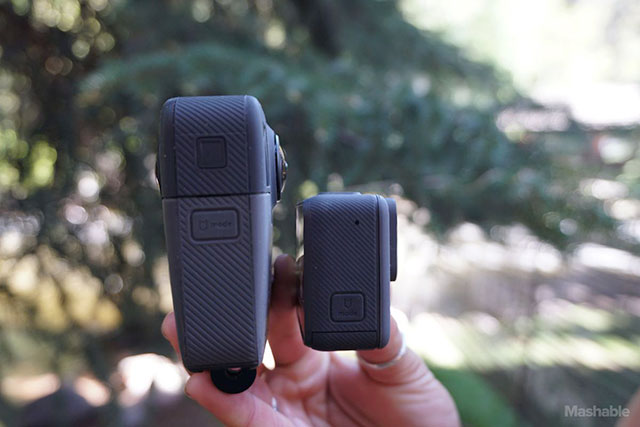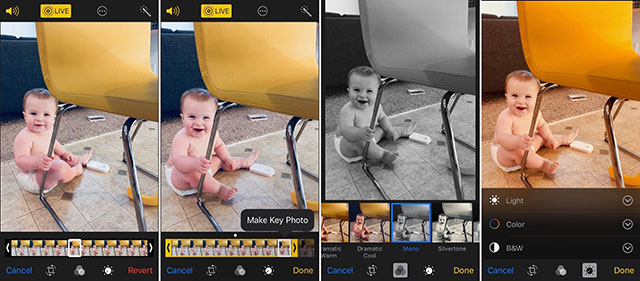Looking back on a promising year for cameras
The article is in the 2017 summation series of technology giants in the world. Invite readers interested in following this series here Looking back at the year 2017 of technology giants in the world.
Digital photos are facing changes. The fact is that with some cameras coming out in 2017, the change has begun. Last year we were an exciting year for the camera, but the past 12 months have also shown more clear signs of fundamental change in photography. And most of them come from the advancements of computer software and photography.
Look at the 360-degree camera for ordinary users. Professionals have spent many years creating high-end VR products using high-resolution 360-degree cameras, but ordinary users still have to wait. Samsung's second-generation Gear 360 released this year is cheaper, faster and captures higher quality photos. Even so it is still quite boring. Meanwhile, Essential Phone's 360 camera records video very badly and works unstable.
But when these 3 cameras appear, everything is different: Insta360 One, GoPro Fusion and Rylo . All 3 give perfect 360 degree products. The companies that created these cameras exploited the fact that we still watch videos in rectangular form so instead of using 360 cameras to shoot raw 360 videos, they are rotating in spherical form and from there to adjust.

GoPro has become the choice for both professional videographers
These cameras 'way of working first, taking the following frame' is the core. The camera turns in many directions and when viewed again, you can take the frame as if you were behind the whole scene and decide where to shoot. Not only does it help ensure you don't miss anything, this way also opens up many creative opportunities. There are also many other useful approaches to GoPro Fusion, for example, with videos of 'small planets' or modes that make the camera look like it is in front (or next to) the subject.
These things all made it possible to shoot 360 degrees on a professional camera, but making a $ 500 camera or smartphone is a big step this year. What's even more interesting is that the potential is still untapped because smartphones use both front and rear cameras. Imagine when shooting, you don't need to focus on the subject anymore because you can cut the picture later? What will our use and relationship with 'pocket cameras' be?
Perhaps you will ask yourself the same questions, especially when leading technology companies are creating countless crazy approaches in their own way, to change the way we take photos with mobile.

Live Photos has become very hot on the iPhone
For example, Live Photos on iOS 11. Previously a cute little feature, now extremely useful and ready to use all the time. With Live Photos, if you miss a scene because someone closes your eyes or moves your child, you can choose another frame. Apple also added the ability to mix frames to create exposure shots.
- The effective tricks to exploit features on iOS 11 Camera
- How to edit Live Photos on iOS 11
And then Google, now a leader in the computer photography revolution. The way they combine multiple photos when you press the shutter button (which started with Google Glass) has blossomed since the launch of Pixel 2 this year, making them the most respected name in today's mobile photography market. .
Surprisingly, Google also brought image processing to the 2nd generation Pixel, making people think about where computer photography will go? Is it possible to remove objects that cover the main subject in the image or quickly color the image?
- This is why you should buy Pixel 2 instead of iPhone X
- Google announced the new Pixel 2 phone
Leaving mobile photography aside, not to mention the Light L16 , the camera looks very strange with 16 camera modules, including 3 wide-angle tubes, 3 mid-range tubes, and 3 telephoto tubes. The camera uses computational photography to mix images together, producing images like those taken with tubes of 28-150mm. Again an unprecedented idea of blossoming this year. It may not be long before it appears again on mobile, in fact Light is also working with a secret manufacturer.
Saying that doesn't mean 2017 only has software. There are also many traditional digital cameras that have crossed the boundaries before, like the super-fast Sony A9 and slightly slower twins Sony A7R III. Canon also released the long-awaited 6D Mark II . Nikon has D850.
All the advances these cameras bring are not comparable to the questions posed by computer photography. Will a person who uses a smartphone with a camera turn all the way with a zoom like a telephoto tube? What about a camera that makes anyone in a photo look good?
See more:
- Compare the best photography smartphones in 2017
- Admire the short film shot entirely by iPhone X
- The best camera app for Android
You should read it
- [Review] Should I buy a GoPro Hero 7 Black camera? Detailed user guide
- Video: Drop the camera in hot water to shoot ... boiled eggs
- New features on iOS 10 Camera app
- How is AI impacting mobile photography?
- GoPro for WP update supports Camera Hero 4
- How to connect GoPro to a Mac
- These times should not use camera metering
- This is a portrait shot that removes fonts (Portrait Mode) on Pixel 2 without Pixel 2
May be interested
- How to keep home security cameras safe?
 hidden surveillance cameras are a quite popular device today in families to ensure security. however, if security cameras are not used properly, users themselves can become victims of privacy invasion risks.
hidden surveillance cameras are a quite popular device today in families to ensure security. however, if security cameras are not used properly, users themselves can become victims of privacy invasion risks. - Top digital cameras for children
 finding the best camera for your child can be a great way to help them get creative while having fun – and it's never too early to start!
finding the best camera for your child can be a great way to help them get creative while having fun – and it's never too early to start! - Review of 2017 by Microsoft
 if 2016 is the year for the back-to-back failures, 2017 is the year that microsoft is fully focused.
if 2016 is the year for the back-to-back failures, 2017 is the year that microsoft is fully focused. - How to enable Back Tap on iOS 14, how to use Back Tap
 back tap is a feature to touch the back of the iphone 2 or 3 times to perform certain actions that have just been added by apple on the ios 14 operating system version.
back tap is a feature to touch the back of the iphone 2 or 3 times to perform certain actions that have just been added by apple on the ios 14 operating system version. - Future high-end Nokia phones may have 5 cameras
 some phones now have four cameras, with two on the back and two on the front, but an upcoming nokia phone can outperform with 5 camera lenses.
some phones now have four cameras, with two on the back and two on the front, but an upcoming nokia phone can outperform with 5 camera lenses. - Prayers for all Year-end New Year's Eve at the end of the year
 the prose of the year of the new year festival is an indispensable part of the year-end ceremony of the year-end eve. the year of the monkey is usually carried out on the last days of the year, the range of 27, 28 lunar calendar onwards, but mostly on the 30th day of the lunar new year (the 29th day of the lunar month).
the prose of the year of the new year festival is an indispensable part of the year-end ceremony of the year-end eve. the year of the monkey is usually carried out on the last days of the year, the range of 27, 28 lunar calendar onwards, but mostly on the 30th day of the lunar new year (the 29th day of the lunar month). - Top best mirrorless cameras in 2019
 you will find many types of mirrorless cameras. remember, a mirrorless camera is sometimes called a compact camera system (csc) or an m4 / 3 sensor camera.
you will find many types of mirrorless cameras. remember, a mirrorless camera is sometimes called a compact camera system (csc) or an m4 / 3 sensor camera. - Instructions to make your camera from a simple matchbox
 today, taking photos becomes too easy and simple with a travel camera to smartphones. however, with just a bit of creativity, you can turn a matchbox into a beautiful and extremely small film camera.
today, taking photos becomes too easy and simple with a travel camera to smartphones. however, with just a bit of creativity, you can turn a matchbox into a beautiful and extremely small film camera. - Xiaomi security cameras show pictures of strangers' homes, Google immediately disables these devices
 after receiving a report from a xiaomi camera user about detecting strange images from other cameras appearing on their nest hub screens, google immediately disabled these devices.
after receiving a report from a xiaomi camera user about detecting strange images from other cameras appearing on their nest hub screens, google immediately disabled these devices. - Looking back on a year on Facebook via video Year in Review 2018
 year in review 2018 facebook has officially updated all facebook accounts to celebrate the past 1 year.
year in review 2018 facebook has officially updated all facebook accounts to celebrate the past 1 year.










 Technology world panorama in 2017
Technology world panorama in 2017 What is a Chromebook and how is it different from a Laptop?
What is a Chromebook and how is it different from a Laptop? Microsoft's dream of Windows on phones is dead, now is the time for Plan B
Microsoft's dream of Windows on phones is dead, now is the time for Plan B How is Microsoft turning Android into a mobile OS for Windows?
How is Microsoft turning Android into a mobile OS for Windows? What is Satoshi? 1 Satoshi is how many Bitcoin?
What is Satoshi? 1 Satoshi is how many Bitcoin? What is Bitcoin faucet? What is Bitcoin faucet?
What is Bitcoin faucet? What is Bitcoin faucet?